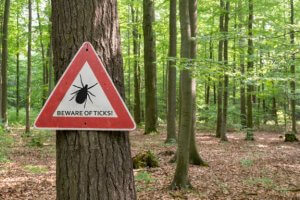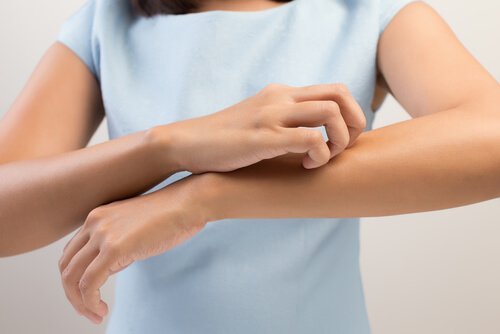What to Do in the Case of Tick Bites

In most cases, tick bites don’t cause any more harm than a bit of reddening, itching and swelling around the bite. However, this type of parasite can transmit illnesses through their bites if they remain on the skin for some time. If this occurs, it’s important to seek medical attention.
What to do in the case of tick bites
As we’ve mentioned above, tick bites don’t usually cause illnesses. However, the saliva in female ticks can contain a toxin that causes what’s called Lyme disease, if the tick remains attached to a person’s skin for several days.
Symptoms of tick bites
Below is a list of the symptoms that tick bites usually produce. Of course, symptoms may vary from one individual to another. Some people may only experience one symptom while others may experience numerous symptoms.
- Swelling of the skin around the tick bite.
- Reddening of the area.
- Headache.
- Difficulty breathing.
- Impaired muscle coordination.
- Full body rash.
- Total paralysis.
- Fever.
If you notice you have a tick bite right away
If you notice right away after being bitten by a tick, there are a series of steps to take to extract the parasite.
Extraction with tweezers
Use a pair of tweezers with a narrow tip to extract the insect. Aim for the tick’s mouth – the part closest to the person’s skin. It’s important not to squash the tick’s body.
The act of removing the tick should be slow and continuous and perpendicular to the skin. You should never use sudden movements or twisting motions. It’s especially important not to crush the tick.
Don’t use any products like nail polish remover, vaseline or any other substance in an attempt to improve extraction. They may actually make things worse.

Sometimes, a part of the tick may detach and remain stuck in an individual’s skin. If it’s the tick’s mouth area, which we mentioned earlier, then you should notify your doctor. That way, he or she can try to extract the remains with a small incision in the area.
If it happens to be another part of the tick’s body, then the individual’s body may expel it on its own within a few days.
Save the tick
If you have the possibility of keeping the tick, do so. Place it in a sealed bag or put it in the freezer until you can see a doctor. This will allow the doctor to identify the type of tick, meaning he or she may be able to make a more complete diagnosis.
Disinfection
Once you’ve finished the extraction process, you should follow the steps below:
- Wash your hands with soap and water. If you have sanitizing gel or rubbing alcohol, use that as well.
- Wash the affected area with soap and water. Again, disinfect the bite zone with alcohol.
- Keep the affected area clean at all times.
- Don’t scratch.
- Apply a cold compress to the affected area.
How to prevent tick bites from occurring
Ticks are common in wooded areas as well as tall grassy areas with bushes and shrubs. That’s why, if you take a trip to the country, you should use long sleeves and long pants. This will help keep ticks from latching onto your skin.
It’s also a good idea to tuck your pant legs into your socks. Even if you’re wearing pants, if they’re open at the bottom, bugs can crawl up easily to reach your skin. If you tuck your pants into your socks, you keep this from happening.

It’s also important to use insect repellent. Don’t just spray it on your skin, but also on the clothes you’ll be using while you’re out. This will provide more complete protection.
You should reapply repellent every hour or two hours so that its effect doesn’t wear out. That way, you’ll be sure to have continuous protection.
If you have animals in your home, you should be sure to treat them for parasites regularly to avoid spreading. This is especially true in the case of cats and dogs, as the most common type of tick is the brown dog tick.
In most cases, tick bites don’t cause any more harm than a bit of reddening, itching and swelling around the bite. However, this type of parasite can transmit illnesses through their bites if they remain on the skin for some time. If this occurs, it’s important to seek medical attention.
What to do in the case of tick bites
As we’ve mentioned above, tick bites don’t usually cause illnesses. However, the saliva in female ticks can contain a toxin that causes what’s called Lyme disease, if the tick remains attached to a person’s skin for several days.
Symptoms of tick bites
Below is a list of the symptoms that tick bites usually produce. Of course, symptoms may vary from one individual to another. Some people may only experience one symptom while others may experience numerous symptoms.
- Swelling of the skin around the tick bite.
- Reddening of the area.
- Headache.
- Difficulty breathing.
- Impaired muscle coordination.
- Full body rash.
- Total paralysis.
- Fever.
If you notice you have a tick bite right away
If you notice right away after being bitten by a tick, there are a series of steps to take to extract the parasite.
Extraction with tweezers
Use a pair of tweezers with a narrow tip to extract the insect. Aim for the tick’s mouth – the part closest to the person’s skin. It’s important not to squash the tick’s body.
The act of removing the tick should be slow and continuous and perpendicular to the skin. You should never use sudden movements or twisting motions. It’s especially important not to crush the tick.
Don’t use any products like nail polish remover, vaseline or any other substance in an attempt to improve extraction. They may actually make things worse.

Sometimes, a part of the tick may detach and remain stuck in an individual’s skin. If it’s the tick’s mouth area, which we mentioned earlier, then you should notify your doctor. That way, he or she can try to extract the remains with a small incision in the area.
If it happens to be another part of the tick’s body, then the individual’s body may expel it on its own within a few days.
Save the tick
If you have the possibility of keeping the tick, do so. Place it in a sealed bag or put it in the freezer until you can see a doctor. This will allow the doctor to identify the type of tick, meaning he or she may be able to make a more complete diagnosis.
Disinfection
Once you’ve finished the extraction process, you should follow the steps below:
- Wash your hands with soap and water. If you have sanitizing gel or rubbing alcohol, use that as well.
- Wash the affected area with soap and water. Again, disinfect the bite zone with alcohol.
- Keep the affected area clean at all times.
- Don’t scratch.
- Apply a cold compress to the affected area.
How to prevent tick bites from occurring
Ticks are common in wooded areas as well as tall grassy areas with bushes and shrubs. That’s why, if you take a trip to the country, you should use long sleeves and long pants. This will help keep ticks from latching onto your skin.
It’s also a good idea to tuck your pant legs into your socks. Even if you’re wearing pants, if they’re open at the bottom, bugs can crawl up easily to reach your skin. If you tuck your pants into your socks, you keep this from happening.

It’s also important to use insect repellent. Don’t just spray it on your skin, but also on the clothes you’ll be using while you’re out. This will provide more complete protection.
You should reapply repellent every hour or two hours so that its effect doesn’t wear out. That way, you’ll be sure to have continuous protection.
If you have animals in your home, you should be sure to treat them for parasites regularly to avoid spreading. This is especially true in the case of cats and dogs, as the most common type of tick is the brown dog tick.
All cited sources were thoroughly reviewed by our team to ensure their quality, reliability, currency, and validity. The bibliography of this article was considered reliable and of academic or scientific accuracy.
- Gutiérrez de la Peña, J. Picadura de garrapatas. Revisión. 1990. [Documento en línea] Disponible en: http://ibdigital.uib.es/greenstone/collect/medicinaBalear/index/assoc/Medicina/_Balear_/1990v5n1/p017.dir/Medicina_Balear_1990v5n1p017.pdf
- Oteo JA, Martínez de Artola V, Gómez-Cadiñanos R, Casas JM, Blanco JR, Rosel L. Evaluación de los métodos de reti- rada de garrapatas en la ixodidiasis humana. Rev Clin Esp 1996; 196: 584-587.
This text is provided for informational purposes only and does not replace consultation with a professional. If in doubt, consult your specialist.








